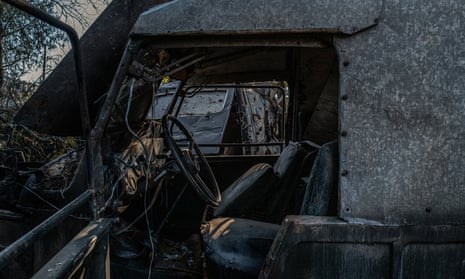Key events
Environmental damage from the eight-month-old war with Russia is mounting in more of the country, with experts warning of long-term consequences.
The warnings come as Russia’s attacks on fuel depots have released toxins into the air and groundwater, threatening biodiversity, climate stability and the health of the population.
The Associated Press spoke to Rick Steiner, a US environmental scientist who advised Lebanon’s government on environmental issues stemming from a monthlong war in 2006 between that country and Israel.
“In addition to combat casualties, war is also hell on people’s health, physically and mentally,” he said.
The Associated Press also reported on how Olga Lehan’s home near the Irpin River was flooded when Ukraine destroyed a dam to prevent Russian forces from storming the capital of Kyiv just days into the war.
Weeks later, the water from her tap turned brown from pollution.
“It was not safe to drink,” she said of the tap water in her village of Demydiv, about 40 kilometers (24 miles) north of Kyiv on the tributary of the Dnieper River.
Visibly upset as she walked through her house, the 71-year-old pointed to where the high water in March had made her kitchen moldy, seeped into her well and ruined her garden.
The absence of the Russian president, Vladimir Putin, in connection with announcements about his forces’ retreat from key areas of Ukraine is being discussed by commentators.
The distance has been deliberate, writes New York Times national correspondent Neil MacFarquhar, who adds:
With each new pronounced setback in Ukraine, however, it is getting harder for Mr. Putin to separate himself from the whiff of failure, which is gradually eroding his image as a decisive, indomitable leader.
Prof Mark Galeotti, an expert on modern Russia, meanwhile suggests that, in apparently ceding power to wiser generals, Putin is learning from his mistakes.
Russian soldiers have been abandoning wounded comrades as they make a retreat from the southern Ukrainian city of Kherson, the Daily Telegraph reports.
Nikolai, a Ukrainian soldier fighting in the region, told the newspaper:
There is a withdrawal of Russian troops to more fortified positions. But there were still populated points where we saw battles.
They withdraw because they suffer losses, very heavy losses. What’s more, they don’t even take the bodies of their soldiers and leave the wounded behind.

The US will buy 100,000 rounds of howitzer artillery from South Korean manufacturers to provide to Ukraine, a US official has said, in a deal the two governments have been working on for some time.
The agreement, reported by the Associated Press (AP) news agency, comes as Ukrainian leaders press for more weapons and aid to take advantage of a counteroffensive that is pushing Russian forces out of some areas they had taken over earlier in the war.
It relieves concerns within the US military, where there have been worries that persistent transfers of the Pentagon’s howitzer ammunition to Ukraine are eating into their stockpiles.
Russian attacks have ‘disproportionate’ impact on civilians – UK MoD

Ben Quinn
Russian attacks on electricity facilities are having a disproportionate effect on civilians in Ukraine, having an indiscriminate impact on critical functions such as healthcare and heating, according to the latest evaluation by the UK’s Ministry of Defence.
“The continued prioritisation of critical national infrastructure over military targets implies Russian intent to strike at civilian morale,” it adds.
The update said Russia had attacked Ukraine with a campaign of strikes since 10 October, targeting electric power infrastructure. This has come in waves, the most recent of which was on 31 October, which involved targeting a hydroelectric dam facilities for the first time.
Recoverability varies and the continued attacks will almost certainly have consequences for interlinked water and heating systems that will be felt most significantly by the civilian population during winter, as demand increases.
This is Ben Quinn in London picking up the blog now for the next few hours.

Martin Chulov
Iran and Russia are finding common ground through the Syrian and Ukraine wars, the Guardian’s Middle East correspondent, Martin Chulov, reports.
When a Russian plane arrived in Iran with €140m in cash and a booty of captured western weapons, in exchange for Iranian drones, it marked a new phase in a seven-year alliance between two unlikely bedfellows.
The delivery of cash and weapons was reportedly made in August, after Russia received its first deliveries of drones to support its war in Ukraine. It was Iran’s first known contribution to the Russian offensive in Europe. But the bond between the two countries had been forged on another continent ravaged by war, the Middle East.
Read the full story below:
Ukrainian officials are reporting an overnight Russian attack on a high-rise building in the southern city of Mykolaiv.
The city’s mayor, Alexander Senkevich, said a residential quarter of the city was shelled, leaving two dead and two wounded.
“Destruction from the fifth to the first floor. So far, two dead and two injured are known. The emergency services continue the search and rescue operation,” he said.
US to send $400m more in military aid to Ukraine
The US will send $400m more in military aid to Ukraine, officials announced on Thursday.
According to the Pentagon, the aid package will contain large amounts of ammunition and, for the first time, four highly mobile Avenger air defence systems.
I have directed another $400 million worth of arms and equipment from @DeptofDefense inventories to Ukraine. This is our 25th drawdown since August 2021. As Ukraine’s defenders push back Russia’s forces, the United States stands #UnitedWithUkraine.
— Secretary Antony Blinken (@SecBlinken) November 11, 2022
This increased air defence will be critical for Ukraine as Russia continues to use cruise missiles and Iranian-made drones to attack critical civilian infrastructure,” national security adviser Jake Sullivan said.
The US will also buy 100,000 rounds of howitzer artillery from South Korean manufacturers to provide to Ukraine, an official added.
Today we announced additional Ukraine ?? security assistance worth up to $400M w/ a mix of critical battlefield capabilities to help Ukraine defend their homeland. Alongside our int’l Allies & partners, we stand united in our unwavering support of Ukraine’s self-defense. pic.twitter.com/9MdKapi98I
— Secretary of Defense Lloyd J. Austin III (@SecDef) November 10, 2022
Russian withdrawal from Kherson city will take one week, Ukraine says
Ukraine’s defence minister Oleksii Reznikov has said it will take at least one week for Russia to pull out of Kherson city.
Russia still has 40,000 troops in the region and intelligence showed its forces remained in and around the city, Reznikov said in an interview with Reuters on Thursday.
It’s not that easy to withdraw these troops from Kherson in one day or two days. As a minimum, [it will take] one week.”
He added that intelligence showed Russia’s forces remained inside the city, around the city and on the west bank of the Dnipro.
Vadym Skibitsky, Ukraine’s deputy military intelligence chief, estimated more than half the Russian forces that had been stationed on the right bank of the city were still there – a force that had previously been put at 20,000.
Ukraine closes in on Kherson, reclaims dozens of towns
Ukraine says its forces have reclaimed dozens of landmine-littered towns and villages abandoned by Russian troops in southern Ukraine as they close in on the outskirts of strategic capital city of Kherson.
In his Thursday evening address, Volodymyr Zelenskiy said that “dozens of Ukrainian flags have already returned to their rightful place”.
Today we have good news from the south,” the Ukrainian president said. “Forty-one settlements were liberated.”
Ukraine claimed it had liberated the key town of Snihurivka, about 20 miles (32km) north of Kherson. Images also emerged of Ukrainian soldiers with a Ukrainian flag in Kyslivka, a village just outside Klapaya and about nine miles (15km) from Kherson’s city centre.
The large pocket around the city once held by Russian forces also appeared to be shrinking. Video posted by Russian soldiers retreating across the Dnipro appeared to confirm that at least some troops had already withdrawn.

Kyiv has said it is wary of rushing in and claiming victory, warning it may be a trap by the Kremlin.
Ukraine’s army chief, Valeriy Zaluzhnyi, said Kyiv could not yet confirm whether Russia was indeed pulling out of the city, but said Kyiv’s forces have advanced 36.5km (22.7 miles) and retaken 41 villages and towns since 1 October in the region.
That included 12 settlements on Wednesday alone.
Summary and welcome
Hello and welcome back to the Guardian’s live coverage of the war in Ukraine. I’m Samantha Lock and I’ll be bringing you all the latest developments as they unfold over the next few hours.
Ukraine says its forces have reclaimed dozens of landmine-littered towns and villages abandoned by Russian troops in southern Ukraine as they close in on the outskirts of strategic capital city of Kherson.
However, Ukraine’s defence minister, Oleksii Reznikov, said it would take at least one week for Russia to pull out of Kherson city and Moscow still has 40,000 troops in the region.
For any updates or feedback you wish to share, please feel free to get in touch via email or Twitter.
If you have just joined us, here are all the latest developments:
-
Ukrainian forces are closing in on the outskirts of the southern city of Kherson after Russia’s announcement its forces have begun retreating. Ukraine claimed it had liberated the key town of Snihurivka, about 20 miles (32km) north of Kherson. Images also emerged of Ukrainian soldiers with a Ukrainian flag in Kyslivka, a village just outside Klapaya and about nine miles (15km) from Kherson’s city centre.
-
The Russian defence ministry confirmed its withdrawal in the region was under way. “The Russian troop units are manoeuvring to a prepared position on the left bank of the Dnipro River in strict accordance with the approved plan.”
-
Ukrainian troops continued their advance on Kherson from the north, east and west, as the large pocket around the city once held by Russian forces appeared to be shrinking. Video posted by Russian soldiers retreating across the Dnipro appeared to confirm that at least some troops had already withdrawn.
-
Ukraine’s defence minister said Russians will take at least a week to leave Kherson city and Moscow still had a contingent of 40,000 troops in the Kherson region. “It’s not that easy to withdraw these troops from Kherson in one day or two days. As a minimum, (it will take) one week,” Oleksii Reznikov told Reuters. He added that intelligence showed Russia’s forces remained inside the city, around the city and on the west bank of the Dnipro. Vadym Skibitsky, Ukraine’s deputy military intelligence chief, estimated more than half the Russian forces that had been stationed on the right bank of the city were still there – a force that had previously been put at 20,000.
-
Kyiv has said it is wary of rushing in and claiming victory, warning it may be a trap by the Kremlin. Ukraine’s army chief, Valeriy Zaluzhnyi, said Kyiv could not yet confirm whether Russia was indeed pulling out of the city, but Kyiv’s forces have advanced 36.5km (22.7 miles) and retaken 41 villages and towns since 1 October in the region. That included 12 settlements on Wednesday alone.
-
There were unconfirmed reports of explosions from shelling around the Nova Kakhovka dam late on Thursday. Kyiv has repeatedly warned that the 30-metre high hydroelectric facility could be targeted by the Russians.
-
Ukrainian forces have liberated 41 settlements as they advanced through the south, president Volodymyr Zelenskiy said in his Thursday evening address. Ukraine is working on ridding areas retaken from Russian forces of thousands of unexploded landmines and ordnance that has been left behind.
-
America’s top general and chairman of the Joint Chiefs of Staff, estimates that Russia’s military had seen more than 100,000 of its soldiers killed and wounded in Ukraine, adding that Kyiv’s armed forces has “probably” suffered a similar level of casualties. Mark Milley’s remarks offer the highest US estimate of casualties to date.
-
The UK government has frozen more than £18bn of assets belonging to oligarchs and other Russians under the new sanctions regime. Sanctions have been imposed on 1,271 people – including the former Chelsea FC owner Roman Abramovich and the “Nickel King” Vladimir Potanin, Russia’s second richest person – according to a report published on Thursday.
-
The US will send $400m more in military aid to Ukraine, officials announced on Thursday. According to the Pentagon, the aid package will contain large amounts of ammunition and, for the first time, four highly mobile Avenger air defence systems. “This increased air defence will be critical for Ukraine as Russia continues to use cruise missiles and Iranian-made drones to attack critical civilian infrastructure,” national security adviser Jake Sullivan said. The US will also buy 100,000 rounds of howitzer artillery from South Korean manufacturers to provide to Ukraine, an official added.








